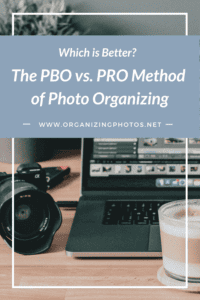Welcome, dear reader, to another fun debate: the PBO photo organizing method vs. the PRO photo organizing method. Plus the ever-interesting question of how many photos you really should pass on. How should you best approach your photo organizing project? Ah, that depends, you see, and that’s what we’re discussing this time around. Read on, and share your thoughts with us in the comments!
What’s Your Best Excuse?
Over the past decade of being a professional photo organizer, I’ve heard my fair share of excuses as to why it’s so hard to get organized. The reasons range all the way from practical and yes – completely valid – to the other end of the spectrum (i.e. “the dog ate my homework”). The outcome is always the same though: no photos get organized. That’s not what I want, so this conundrum is something I spend a lot of time pondering. How can it best be solved?
In order to walk you through what I believe to be the best solution, let me first illustrate what the top 5 objections are for not taking immediate action, in order of appearance:
Top Reason #1: Overwhelm
Overwhelm is by far the biggest reason why people don’t take action. It doesn’t matter what type of project it is. It could be photo organizing, but it could also be something entirely different. I hear it all the time: “Oh, my gosh, there’s just so much to get done. I don’t know where to start.” That could be said about pretty much any project, right? And it’s true. There is always a lot to do, but that doesn’t mean we have to feel overwhelmed by it.
Overwhelm, in its essence, is nothing more than a primal fight or flight response. It’s basically your body letting you know that there’s too much happening all at once. When you are starting a new project, you’re faced with a number of choices, and if you don’t have all the answers, you’ll naturally feel overwhelmed. When we are bombarded with questions we don’t know how to answer, we perceive that as a threat. Big learning curves make us hesitate and question our abilities. That’s uncomfortable.
The key to overcoming overwhelm is to acquire better project management skills. Very rarely do I get overwhelmed, and I do credit my P.M. skills for that – no question are they the differentiator. I know how to break things down, prioritize, and tackle one piece at a time, so there’s never a reason to panic. I want you to have the benefit of that peace too.
Regardless of what type of project or challenge you have in front of you, it all comes down to good project management. As I mentioned in my blog series Divide & Conquer, the planning phase is the most important, yet most often skipped, part of any project. Learn that bit, and you’ll get a lot more done. Trust me on that.
Top Reason #2: Lack of Time
The second most popular reason for not taking action is a perceived lack of time. I say “perceived” because that’s really what it is. I hear things like “I don’t think I can find the time.” Translation? “It’s not a priority” right now. If you want to find the time, there’s always a way. Maybe you just don’t know how yet? Others blurt out “Well, this is just going to take me too long.” That may also be true…but in all fairness, what does “too long” mean to you? We have to be a bit more specific.
Human beings are notoriously bad at estimating time. “How long is this going to take?” is by far the hardest question to answer in any project. We can’t possibly know because there is a learning curve to any new project. That, in and of itself, means that there are too many variables to calculate. It’s only when you have repeating areas of operations (services, offers, etc.) as a business owner, that you can provide those answers. You must have done the same thing before, overcome the learning curve, and have data to look back on. As a DIYer, those facts will not be available to you.
Of course, it’s going to take a while. The question becomes – is this important enough to prioritize? If not, let it go. If yes, you either have to put in the time, or make a conscious effort to outsource. We all have the same 24 hours in a day, and we get to decide what we do with them.
Notice how – once again – the essence here is good project management skills.
Top Reason #3: Cost
“I don’t know how much this is going to cost.” That’s right. You don’t. And you can’t know, unless you are a business owner providing services. Once again, there are too many variables in any new project to calculate accurately.
That being said, we can have an idea for how much we want to invest. That’s different because that number comes from you. We’d all love to have limitless funds, of course, but that’s usually not the reality, so cost will always be a valid factor. And just like with any project – if you can pay to outsource, that’s an option. If not, you’re on your own…or you’ll have to barter with someone.
Outsourcing works because as professionals, we get paid to focus. We have the time, energy, and funds to focus on getting the job done in a short amount of time. That’s our job. That’s what we do. We work on speed and turnaround, so that we can service as many clients as possible.
If you are DIY-ing a project, it’s a very different story. You don’t necessarily have the time, the energy, the funds to focus 100%. There’s other things happening in your life that may require prioritization too. That’s why, for a DIY project, the key to making it cost effective is to break it down into smaller phases over time. That way, you can focus in stages, take breaks when necessary, and not pay for everything in a big lump sum. Instead, you pay over time, and you won’t feel the pinch as much.
Notice here that – once again – good project management skills are key.
Top Reason #4: Unclear Goals
As a professional, I’m never unclear on the goals of a project. That’s a big part of the planning stage. Without knowing the outcome, how can I do my job? I can’t. I have to know what the expectations are for each project and all associated tasks.
DIY projects need the same type of planning, but a lot of people are unclear on their goals. “Why am I doing this? What am I trying to create?” Without having a clear answer to those questions, you won’t be clear on the steps to get things done. The hesitation of “Am I doing this correctly?” will sink your motivation real fast. Unsure people don’t proceed.
You need a very clear goal with a very clear outcome for any project to be completed. It will keep you focused. Without that, it’s very hard to sustain motivation. If a project sits stale and doesn’t move forward, it eventually turns into guilt, and that’s not motivating. We want to sustain motivation by completing what we start, and we do that by having clear goals and breaking them down into smaller steps.
Notice how this all reverts back to project management skills.
Top Reason #5: Limited Tech Skills
Rounding out our top five is the classic: “I’m too [insert reason] for this.”
I’ve heard them all. “I’m too old to learn this.” “I’m too time-constrained to learn technology.” “I’m too insecure to learn…I’ll never be able to figure it out.” This is never a real excuse because we are all very capable. This is a rule you make up to limit yourself and to give yourself an “out.” It’s simply the overwhelm coming back to haunt you in another form.
How do we get over this? Yep, you got it. By breaking things down into smaller steps, and learning taking one step at a time. In other words, by planning our work and working our plan. Simple as that.

I’m a Perfect Pinnable!
Problem, Meet Solution.
What we can glean from these top five excuses is that – no matter what form it comes in – it boils down to the same thing: project management. Your project management skills are what really matters in getting things done. Nothing else.
For overwhelm, we plan our work and break things down into smaller steps. To avoid being short on time, we break things down into smaller steps, so we can complete them faster and gain momentum. To avoid large costs, same thing. We break down projects into smaller phases, so we can pay over time rather than in a lump sum. We complete our projects with clear goals that we get from the planning phase, which – again – is project management. That flow maintains motivation and helps us improve our tech skills incrementally over time.
These big five excuses that I’ve observed over the past decade have led me to teach the PBO photo organizing method alongside of the PRO method, and I can’t wait to tell you more about it.
Before we get into that though, let me ask you a question:
How many photos do you want to pass on? 10? 100? 1000? 100,000? Not sure? Ah, the power of clear goals.
How Many Photos Should You Reasonably Pass Down?
There’s an ongoing debate in the photo organizing industry about how many photos you should reasonably pass down. It’s a really thought-provoking question, and I don’t know that any of us have the best answer to it.
Some people on one side (camp one) in the industry argue: ”Well, we need to pass down 1,000 photos or less because there is this forthcoming photo avalanche that’s going to hit our children, grandchildren, and great-grandchildren.” And they’re right. Let’s say you have 100,000 photos in your collection. Then think about yourself as a grandparent passing those photos on. Your grandchild could expect to get about 100,000 photos from at least eight grandparents plus account for their own and their parents’ photos. That’s close to a million photos in less than two generations. Isn’t it better to curate? That’s the argument on that side.
The argument on the other side (camp two) says that “storage is so cheap, especially cloud storage, that we don’t need to curate anything.” We can just upload as much as we want, and then let AI (Artificial Intelligence) take over. Yes, it may not be fully developed yet, but it’s come a long way in a short few years. Eventually, somebody will come up with something that organizes everything for us automatically. Why should we spend the time on it? They might be right too. Who really knows?
Depending on your vantage point on this topic, your ideal method usually reveals itself. Members of camp one tend to lean towards the PBO photo organizing method. Camp two tends to go more towards the pro method because of their volume of photos. Which side do you land on?
My Take On This Debate
Organizing may happen automatically at some point in the future – I don’t argue with that at all – but for me, that part doesn’t matter. The organization isn’t necessarily “the thing” I want to pass down. I want to pass on the stories. And the problem is that while AI can figure out what’s in a photo, it’ll have a harder time understanding why I took it. It will never know the reason why I chose to move somewhere. It’ll never know the reason why I chose to marry my husband, or why I traveled to a certain place. That context is crucial. That’s why I lean more towards curation and less towards AI overall.
That being said, I don’t want to do more work that needed. There has to be a happy medium somewhere, right?
Introducing the PBO Photo Organizing Method
With all of the above in mind, let me introduce you to the PBO photo organizing method. PBO stands for “Project-Based Organization.” This is a way to tackle your photo collection at a slower pace and in smaller chunks than traditional or “professional” (the “pro” method) organizing. It’s based on putting creative projects in the forefront and selecting a limited number of quality photos to keep and pass down. Not larger quantities.
Using the PBO method, you may end up saving a total of 5,000-10,000 photos at most. In traditional photo organizing, we’re usually looking at 50,000 minimum.
That’s why PBO is a really good approach for people who end up on that minimalistic side of things. If you like the idea of curation, you’ll love this method. It works great for anyone who is creative, deals with overwhelm, or simply struggles with time constraints.
The PRO vs. PBO Photo Organizing Method: Which is Better?
The “pro” method, which most professional organizers use, optimizes the process for efficiency. It gets everything done at once, and the focus is on speed. We batch large volumes of work because we have enough time, funds, and expertise to do so. A professional has a different goal and priority than a DIYer. A business owner wants to turn over projects quickly because that equals profit. Time is of the essence.
For a person doing a project like this on their own, time is clearly not the only factor. That’s where the PBO method wins out. The PBO photo organizing method recognizes that putting stories to hundreds of thousands of photos is a tall order. That’s why we first optimize the organizing process for creativity and get the most important stories shared first. Then we use that process to organize as a by-product. It’s a fantastic way to get things done in a fun and less overwhelming way.
Let me be clear. Both processes are fantastic, so we can’t compare them directly to each other. That’s apples to oranges. What matters is which method is better for YOU. What’s gonna get your project over the finish line?
Organizing is a Means to an End
Organizing for organizing’s sake isn’t all that exciting, is it? Actually, it is to me (that’s why I do this work), but you know what I mean. It’s not necessarily the best thing since sliced bread – for YOU. The outcome is everything.
If the memories were shared and eventually passed on, you succeeded. Right? That’s the goal. In the very end, you either passed on something or you did not. How you did it is less important. None of your descendants are going to focus on the steps you took to preserve your family legacy. All that matters is that there is one. That’s why I feel like you should be allowed to choose which method works for you. The end goal should always be the same, and that’s to preserve the stories.
Overwhelmed? Use PBO, i.e. the “Storytelling” Approach
If you feel overwhelmed or don’t know where to start, I invite you to take a storytelling approach to your project. Use the PBO photo organizing method and feel great about it. Speed does not need to be the only criteria. We just need to get to the right outcome. That’s what matters.
If you’re interested in learning more about my PBO photo organizing method and jump into some fun creative projects, have a look at the free sneak peek of the workshop we recently did for it. It’s available over on the YouTube channel and embedded below. You’ll get a great overview there, and then if you think it might be the right fit, you can dive in deeper.
We welcome your enrollment in the full workshop, and of course, for the bigger picture perspective and more step-by-step help, including the coveted pro method, you can join us anytime in DPO PRO: The Ultimate Photo Organizing Masterclass.
I’m intrigued to hear your takeaways on what criteria is most important to you as you start organizing your photos. Is it speed? Is it to keep the costs down? Is it to enjoy the process and create fun projects while you do it?
Let us know in the comments below!
Featured Photo Courtesy of Mylene Tremoyet





